Drones
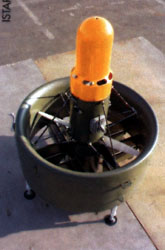
iStar
Developer Allied Aerospace, Newport News, Virginia
Diameter 9 in.
Height 12 in.
Weight 5 lbs.
Radius of action 5.5 miles
The lowdown DARPA is flight-testing the Star, which would be fitted with a sensor suite (electra-optical, infrared, radar). iStar hovers like a helicopter but also flies forward by pitching to a near-horizontal attitude. The iStar�s lifted, augmented, ducted fan is reminiscent of a "ring wing" UAV that General Dynamics� Convair division test-
ed in the 1 980s. The iStar flies as high as 16,000 feet and runs for up to an hour.
Status In development
0
0
0
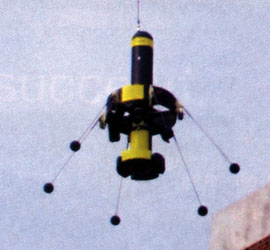
HeliSpy
Developer Micro Autonomous Systems, Del Mar, California
Diameter 11 in.
Height 27 in.
Weight 6 lbs.
Radius of action 25 miles
The lowdown Originally devel�oped for DARPA and now aimed primarily at the commercial mar�ketplace, the HeliSpy II is fully autonomous; it can also be con�trolled by a computer-game-style oystick and reprogrammed in the air. Powered by an inexpen�sive model aircraft engine, the $25,000 craft switches from vertical to horizontal flight to gain speed. One potential use:
Police SWAT teams could send them through a window to search a building where terror�ists are suspected to be hiding.
Status In limited production
0
0
0

Wasp
Developer AeroVironment, Monrovia, California
Length 8 in.
Weight 6 oz.
Radius of action 0.6 mile
The lowdown This 13-inch "fly�ing wing" recently set an endur�ance record, flying for 1 hour 47 minutes, more than three times the previous micro-UAV record, set two years ago. The radio-controlled Wasp has an ingenious design: Its wing is made of a novel synthetic "multi-functional" material-a hot re�search area for DARPA-that, in addition to serving as a wing, supplies electrical energy for pro�pulsion. The next-gen Wasp will incorporate a simple autopilot and carry a color video camera.
Status In early development
0
0
0
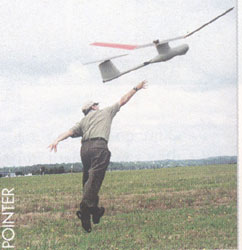
Pointer
Developer AeroVironment
Length 6 ft.
Weight 10 lbs.
Radius of action 3.5 miles
The lowdown Prop-driven, with a 9-foot wingspan, the FOM�1 5 1 Pointer carries a 2-pound payload and is launched by hand. Six Pointer systems are employed at the urban warfare training center at Fort Benning, Georgia. Others serve as test-beds for miniaturized sensors at the Drug Enforcement Adminis�tration. Recently the Pointer was used to keep an eye on demon�strators at Puerto Rico�s contro�versial Vieques bombing range. Equipped with an infrared video camera, the UAV was used to spot and observe trespassers.
Status First deployed by the U.S. military in 1988; sent to Iraq for use by special forces
0
0
0
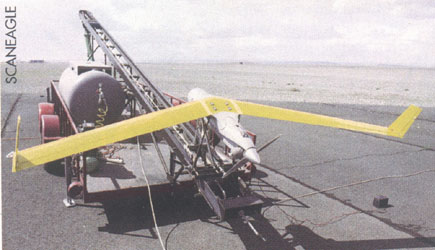 Exdrone/Dragon Drone
Exdrone/Dragon Drone
Developer BAI Aerosystems, Easton, Maryland
Length 5 ft.
Weight 90 lbs.
Radius of action 30 miles
The lowdown Originally built as expendable communications jammers, BQM-1 47A Exdrones (the name stands for "expend�able drone") were, with the addition of a gimbaled electra-optical sensor, reconfigured for reconnaissance work in the late 1 990s. Forty-five Exdrones saw action in the 1991 Gulf War.
Status In service with the Penta�gon since the early 1 980s; now used primarily for war games and other military exercises
0
0
0
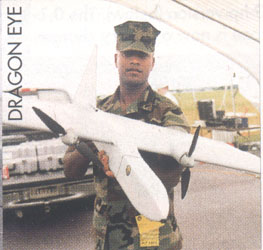
Dragon Eye
Developer Naval Research Lab�oratory and Marine Corps Warfighting Laboratory
Length 2.5 ft.
Weight 5 lbs.
Radius of action 2.9 miles
The lowdown This twin-prop air�plane with a 4-foot wingspan breaks into five pieces to fit into a rucksack. No ground station is required; the person who�s using it is simply equipped with a wearable laptop and communi�cations control box. Hand- or bungee-launched, it carries day�light, low light and infrared imaging systems.
Status Though still in develop�ment, Dragon Eye was pressed into combat in Iraq. AeroViron�ment and BAI Aerosystems are competing for the production contract.
0
0
0
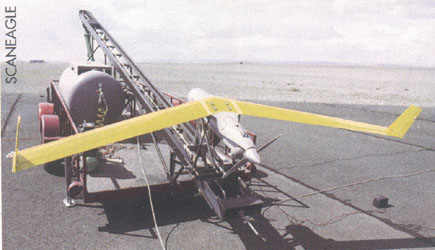
ScanEagle
Developer Insitu Group, Bingen, Washington
Length 4 ft.
Weight 33 lbs.
Radius of action 465 miles
The lowdown Launched from a catapult, ScanEagle is plucked from the air with a wire-and-hook mechanism dubbed SkyHook. With a 10-foot wingspan, Scan-Eagle can stay airborne for up to 15 hours; an engine under devel�opment will allow it to fly for 60 hours and about 5,000 miles.
Status In limited production
0
0
0
Shadow 200
Developer AAI Corp., Hunt Valley, Maryland
Length 11 ft.
Weight 325 lbs.
Radius of action 78 miles
The lowdown The RQ-7A Shadow 200, which can carry up to 60 pounds, is fitted with electra-optical and infrared sen�sors. It has a 1 3-foot wingspan.
Status Now in production, with 41 systems currently funded

Pioneer
Developer AAI Corp. and Israel Aircraft Industries
Length 14 ft.
Weight 452 lbs.
Radius of action 115 miles
The lowdown Launched by rockets or a catapult or from a runway, the RQ-2 Pioneer recov�ers into a net or with arresting gear. During Operation Desert Storm, a detachment of Iraqi sol�diers surrendered to an unarmed Pioneer operating from the battle�ship USS Wisconsin and were taken prisoner by Allied forces.
Status Debuted in 1986; being upgraded to extend its opera�tions until 2009
0
0
0
Dragon Warrior
Developer Naval Research Lab�oratory and Marine Corps Warfighting Laboratory
Length 7 ft.
Weight 230 lbs.
Radius of action 58 miles (est.)
The lowdown This fully autono�mous vehicle is designed for recon and communications relay missions. Its motorcycle-inspired engine is fuel-injected and spark-assisted with a liquid-cooled, 3-cylinder in-line configuration.
Status No flight trials yet

GoldenEye
Developer Aurora Flight Sci�ences, Manassas, Virginia
Diameter 3 ft. Height 5.5 ft.
Weight 150 lbs.
Radius of action 500 miles lest.)
The lowdown A stealthy small-package delivery
system, it�s meant to quietly deposit a 10- or 20-pound sensor behind enemy lines, then scoot. Wings enable it to transition to horizontal flight after getting airborne.
Status At press time, first flight was set for May.
0
0
0

Hummingbird
Developer Frontier Systems, Irvine, California
Length 35 ft.
Weight 5,000 lbs.
Radius of action 1,500 miles
The lowdown The Al 60 Hum�mingbird flies up to 35,000
feet high. It sips fuel thanks to its flight-control system and a hinge-less, variable-speed rotor system.
Status In flight testing for DARPA
0
0
0
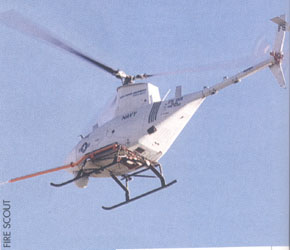
Fire Scout
Developer Northrop Grumman, San Diego, California
Length 23 ft.
Weight 2,650 lbs.
Radius of action 173 miles
The lowdown Based on a Schweizer civil helicopter, the RQ-8A Fire Scout is designed to operate from warships, finding targets for strike aircraft.
Status in flight testing
0
0
0
Eagle Eye
Developer Bell Helicopter, Hurst, Texas
Length 1 8 ft.
Weight 2,247 lbs.
Radius of action Unknown
The lowdown With its rotors in vertical position, the TR9 liX Eagle Eye can take off, hover, and land like a traditional rotary-wing aircraft. By tilting its rotors to the horizontal position, it can fly with the speed and range of a turboprop fixed-wing airplane.
Status Selected by U.S. Coast Guard as a shipboard item
Dragonfly
Developer Boeing, Chicago
Length 17.7 ft.
Weight 1,785 lbs.
Radius of action 108 miles (est.)
The lowdown Aviation Week recently called the X-SOA Drag�onfly Canard Rotor/Wing -the first helicopter to deliberately stop its rotor in flight.- The rotor becomes the aircraft�s wings after a helicopter-like takeoff. Diverter valves direct the thrust to the rotor blade tips for rotary flight or to the aft jet nozzle for high-sub�sonic-speed fixed-wing cruising.
Status: Two demonstrators to fly as early as this month
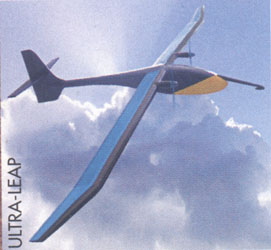
Ultra-LEAP
Developer Boeing
Length 45 ft.
Weight Undetermined
Radius of action Undetermined
The lowdown This craft will run on electricity generated in a fuel cell by a chemical reaction involving hydrogen and oxygen. The engine would spit out water droplets instead of carbon dioxide and other pollutants generated by fuel-burning engines. Ultra-LEAP will have a 150-foot wingspan and carry a 250-pound payload. Its designers intend it to stay airborne for weeks at a time.
Status On the drawing board; two prototypes are anticipated within two years.
0
0
0
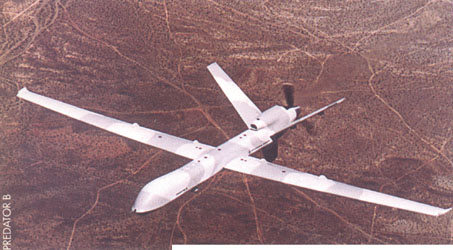
Predator B
Developer General Atomics Aeronautical Systems, San Diego, California
Length 36 ft.
Weight 10,000 lbs.
Radius of action 460 miles
The lowdown The Predator B, or MQ-9A, is a beefed-up ver�sion of the reconnaissance drone that was armed with a pair of laser-guided Hellfire mis�siles during the Afghanistan con�flict. The turboprop-powered B-model carries up to 1 0 missiles, compared to its predecessor�s two. The B-model also operates 20,000 feet higher: at 45,000 to 60,000 feet.
Status In production
0
0
0
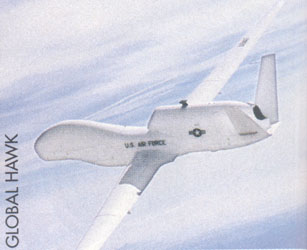
Global Hawk
Developer Northrop Grumman
Length 44 ft.
Weight 26,750 lbs.
Radius of action 6,214 miles
The lowdown The RQ-4A Global Hawk takes off and lands on a conventional runway. Carrying a 2,000-pound payload of sensors, it gathers intelligence day and night and in adverse weather. It can stay aloft up to 32 hours.
Status Still technically in engineering development, Global Hawks were used in Afghanistan and again this year in Iraq. The Air Force plans to field about 30 Global Hawks by the end of the decade and to purchase 5l in all.
0
0
0
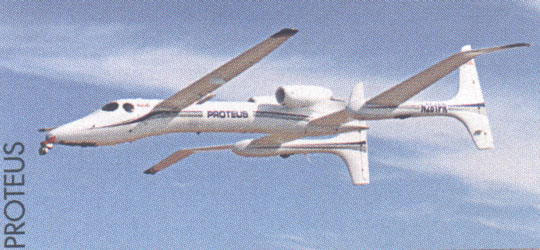
Proteus
Developer Scaled Composites, Mojave, California
Length 56 ft.
Weight 12,510 lbs.
Radius of action 2,300 miles
The lowdown Though designed to fly autonomously, the Proteus has never fulfilled its original purpose and in every flight to date has been piloted. The craft was built to hover over cities at altitudes of 60,000 feet and function as a local broadband communications hub, but that plan fizzled when the telecon�munications industry crashed. Now leased by NASA, the Proteus recently carried a prototype collision avoidance system for UAVs; one of its next tasks will be to hold a target to be shot at during a test of the military�s new airborne laser.
Status First flight in 1998; now used for atmospheric research and other high-altitude tests
0
0
0
X-47A Pegasus Naval UCAV Demonstrator
Developer Northrop Grumman
Length 28 ft.
Weight 4,000 lbs.
Radius of action Undetermined
The lowdown Northrop Grum�man�s prototype for the U.S.
Navy/DARPA UCAV, the Pegasus flying wing is a subscale model with a 28-foot wingspan. It was built in part to demonstrate that an unmanned combat air vehicle could make an autonomous takeoff and landing from an aircraft carrier.
Status Made its maiden flight in February
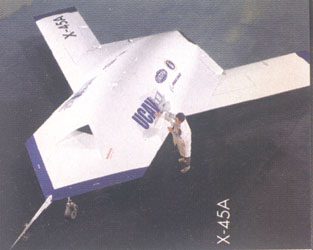
X-45
DeveloperBoeing
Length 26 ft.
Weight 12,000 lbs.
Radius of action Undetermined
The lowdown The X-45 is the first UAV designed from incep�tion for combat. DARPA and the Air Force are currently flight testing two X-45A prototypes. Next, Boeing will build two X-4SBs, which will be more capa�ble and one-third larger than the X-45A. An X-45C is on the draw�ing board. It will more closely represent an operational UCAV.
Status: Fielding of the X-45B or X-45C could occur by 2008.0
0
0
Unmanned Combat Armed Rotorcraft (UCAR)
Developer Undetermined
Length Undetermined
Weight Undetermined
Radius of action Undetermined
The lowdown The UCAR is the Army�s desired unmanned combat air vehicle. This futuristic, robotic vertical-takeoff-and-landing aircraft would perform armed recon and attack missions, alone or with piloted rotororaft. It would extend the reach of manned helicopter gunships and take their place on risky missions. The UCAR, which could be con�trolled from the cockpit of Army helicopters, will be designed to carry rockets, missiles and guns, as well as nonlethal and directed-energy weapons.
Status Fielding might take place between 2013 and 2015..
WHEN IS A UCAY NOT A UCAY?
The Pentagon�s plan for a low-cost, modest vehicle is bloated beyond recognition.
Pilots often volunteer for the most difficult missions, but the Pentagon continues to press ahead with its plan to build an unmanned combat air vehicle, or UCAV, that could fly without risking a pilot�s life. A simple plan, but it�s become increasingly ambitious-though a proven, simple UCAV model exists: Predator. Originally built for recon, the Cessna-size Predator was fitted with Hellfire missiles in 2001 and has since carried out successful strikes in Afghanistan, Yemen and Iraq. The Air Force is testing a bigger version, the MQ-9 Predator B, which carries 3,000 pounds of smart weapons (up from about 400 pounds) and whose 50,000-foot cruise altitude puts it beyond reach of the most common threats-guns and shoulder-fired missiles. A Predator B costs $8 million; the Pentagon�s planned UCAV has an anticipated price tag of at least $25 million.
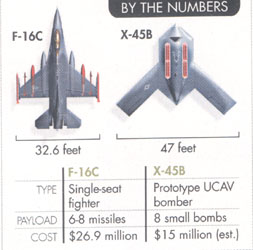 That inflation means the Pentagon has lost sight of its goal, warns DARPA�S first UCAV pro�gram manager, Michael Francis, who�s now at Lockheed Martin. The UCAV as originally con�ceived, he says, "was designed to get us out of the death spiral"-the term for the trend in which each generation of military airplanes costs more and is built in smaller numbers than the one that came before it. If a next-gen UCAV costs three times as much as the current model, one has to wonder whether the military can afford such disposability.
That inflation means the Pentagon has lost sight of its goal, warns DARPA�S first UCAV pro�gram manager, Michael Francis, who�s now at Lockheed Martin. The UCAV as originally con�ceived, he says, "was designed to get us out of the death spiral"-the term for the trend in which each generation of military airplanes costs more and is built in smaller numbers than the one that came before it. If a next-gen UCAV costs three times as much as the current model, one has to wonder whether the military can afford such disposability.
Unmanned combat aircraft not only save
lives; they don�t sleep and so can focus on a
task indefinitely. But lacking a human brain-
what one pilot calls "the five-pound shoulder-
mounted computer"-they can�t be trusted to
tell a Scud from a school bus without the help
of an operator on the ground. If the radio link
is lost, UCAVs go dumb. Given such limitations,
how elaborate should unmanned combat air-
craft be? The original 1 999-era UCAV, the X�
45A, was to cost around $10 million and carry
1,500 pounds of bombs. But the military is now
mulling the X-45C, an F-16-size craft that would
carry 2 tons of bombs. Plans revealed in March
call for the Air Force to have 36 such combat-
ready UCAVs by 2010. Pentagon officials insist
the beefed-up specs are needed: Their new
UCAV will be stealthy, which the Predator is not, twice as swift as Predator, and have greater range and endurance. Says UCAV program manager Col. Earl Wyarn "If we can do the same thing as everyone else, the answer will be, thank you, no, I�ve already got it."




 Exdrone/Dragon Drone
Exdrone/Dragon Drone








 That inflation means the Pentagon has lost sight of its goal, warns DARPA�S first UCAV pro�gram manager, Michael Francis, who�s now at Lockheed Martin. The UCAV as originally con�ceived, he says, "was designed to get us out of the death spiral"-the term for the trend in which each generation of military airplanes costs more and is built in smaller numbers than the one that came before it. If a next-gen UCAV costs three times as much as the current model, one has to wonder whether the military can afford such disposability.
That inflation means the Pentagon has lost sight of its goal, warns DARPA�S first UCAV pro�gram manager, Michael Francis, who�s now at Lockheed Martin. The UCAV as originally con�ceived, he says, "was designed to get us out of the death spiral"-the term for the trend in which each generation of military airplanes costs more and is built in smaller numbers than the one that came before it. If a next-gen UCAV costs three times as much as the current model, one has to wonder whether the military can afford such disposability.